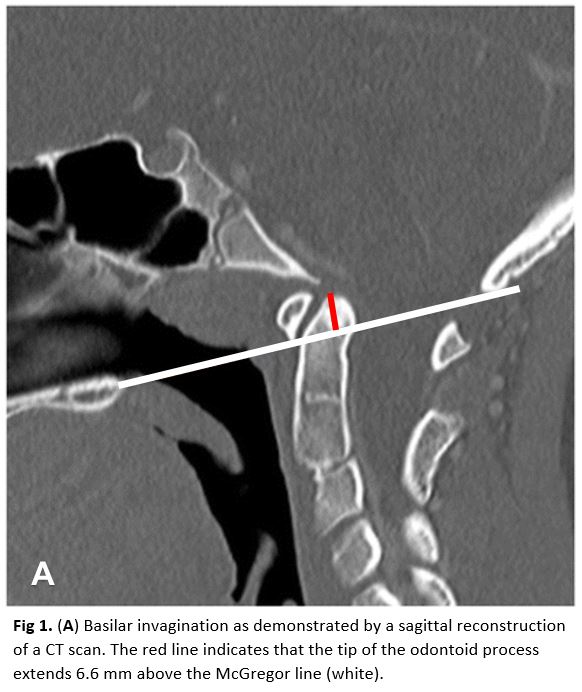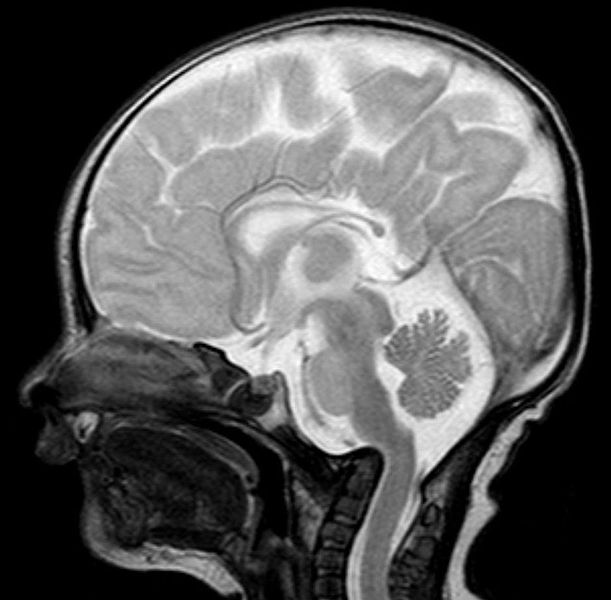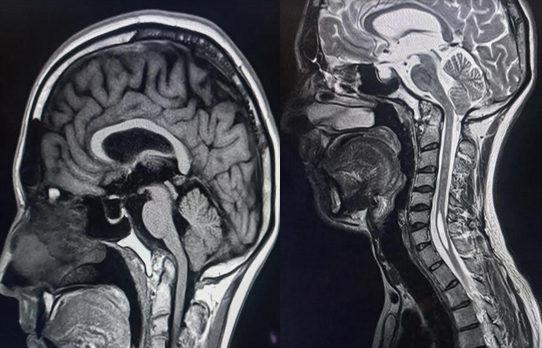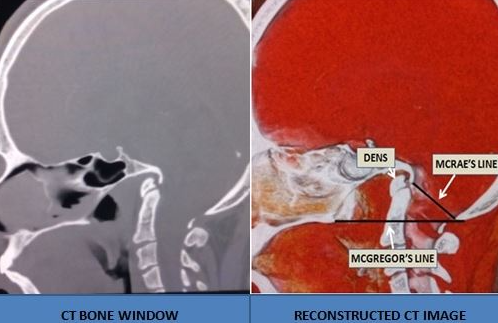[1]
Kahilogullari G,Eroglu U,Yakar F,Beton S,Meco C,Caglar YS, Endoscopic Endonasal Approaches to Craniovertebral Junction Pathologies: A Single-Center Experience. Turkish neurosurgery. 2018 Aug 27;
[PubMed PMID: 30649807]
[2]
Chibbaro S,Ganau M,Cebula H,Nannavecchia B,Todeschi J,Romano A,Debry C,Proust F,Olivi A,Gaillard S,Visocchi M, The Endonasal Endoscopic Approach to Pathologies of the Anterior Craniocervical Junction: Analytical Review of Cases Treated at Four European Neurosurgical Centres. Acta neurochirurgica. Supplement. 2019;
[PubMed PMID: 30610322]
Level 3 (low-level) evidence
[3]
Liao C,Visocchi M,Zhang W,Li S,Yang M,Zhong W,Liu P, The Relationship Between Basilar Invagination and Chiari Malformation Type I: A Narrative Review. Acta neurochirurgica. Supplement. 2019;
[PubMed PMID: 30610310]
Level 3 (low-level) evidence
[4]
Donnally CJ 3rd,Butler AJ,Rush AJ 3rd,Bondar KJ,Wang MY,Eismont FJ, The most influential publications in cervical myelopathy. Journal of spine surgery (Hong Kong). 2018 Dec;
[PubMed PMID: 30714009]
[5]
Ferrante A,Ciccia F,Giammalva GR,Iacopino DG,Visocchi M,Macaluso F,Maugeri R, The Craniovertebral Junction in Rheumatoid Arthritis: State of the Art. Acta neurochirurgica. Supplement. 2019;
[PubMed PMID: 30610306]
[6]
Goel A, Cervical Fusion as a Protective Response to Craniovertebral Junction Instability: A Novel Concept. Neurospine. 2018 Dec;
[PubMed PMID: 30562886]
[7]
Rusbridge C,Stringer F,Knowler SP, Clinical Application of Diagnostic Imaging of Chiari-Like Malformation and Syringomyelia. Frontiers in veterinary science. 2018;
[PubMed PMID: 30547039]
[8]
Botelho RV,Botelho PB,Hernandez B,Sales MB,Rotta JM, Association between Brachycephaly, Chiari Malformation, and Basilar Invagination. Journal of neurological surgery. Part A, Central European neurosurgery. 2021 Dec 20
[PubMed PMID: 34929749]
[9]
Wang X,Ma L,Liu Z,Chen Z,Wu H,Jian F, Reconsideration of the transoral odontoidectomy in complex craniovertebral junction patients with irreducible anterior compression. Chinese neurosurgical journal. 2020
[PubMed PMID: 32944290]
[10]
Ravikanth R,Majumdar P, Embryological considerations and evaluation of congenital anomalies of craniovertebral junction: A single-center experience. Tzu chi medical journal. 2021 Apr-Jun
[PubMed PMID: 33912416]
[11]
Goel A, Basilar invagination, syringomyelia and Chiari formation and their relationship with atlantoaxial instability. Neurology India. 2018 Jul-Aug;
[PubMed PMID: 30038072]
[12]
Goel A, Basilar invagination, Chiari malformation, syringomyelia: a review. Neurology India. 2009 May-Jun;
[PubMed PMID: 19587461]
[13]
Halderman AA,Barnett SL, Endoscopic endonasal approach to the craniovertebral junction. World journal of otorhinolaryngology - head and neck surgery. 2022 Mar
[PubMed PMID: 35619929]
[14]
Lee J,Guk HS,Kim M,Lee EJ, Successful Treatment of Basilar Invagination and Platybasia Associated With Cerebellar Atrophy by Decompression Surgery. Journal of clinical neurology (Seoul, Korea). 2022 Mar
[PubMed PMID: 35274843]
[15]
Peng L,Zuo W,Cheng C,Yang F,Wang P,Mao Z,Zhang J,Li W, Association Between the Clivus Slope and Patient-Reported Japanese Orthopaedic Association (PRO-JOA) Scores in Patients with Basilar Invagination: A Retrospective Study. Turkish neurosurgery. 2021 Nov 26;
[PubMed PMID: 35713252]
Level 2 (mid-level) evidence
[16]
Goel A, Basilar invagination, spinal "degeneration," and "lumbosacral" spondylolisthesis: Instability is the cause and stabilization is the treatment. Journal of craniovertebral junction & spine. 2021 Oct-Dec
[PubMed PMID: 35068814]
[17]
Jian Q,Zhang B,Jian F,Bo X,Chen Z, Corrigendum to "Basilar Invagination: A Tilt of the Foramen Magnum" [World Neurosurgery 164 (2022) e629-e635]. World neurosurgery. 2022 Aug 30
[PubMed PMID: 36058831]
[18]
Jian Q,Zhang B,Jian F,Bo X,Chen Z, Basilar Invagination: A Tilt of the Foramen Magnum. World neurosurgery. 2022 Aug
[PubMed PMID: 35577208]
[19]
Diniz JM,Botelho RV, The role of clivus length and cranial base flexion angle in basilar invagination and Chiari malformation pathophysiology. Neurological sciences : official journal of the Italian Neurological Society and of the Italian Society of Clinical Neurophysiology. 2020 Jul;
[PubMed PMID: 32002740]
[20]
Sardhara J,Behari S,Singh S,Srivastava AK,Chauhan G,Lal H,Das KK,Bhaisora KS,Mehrotra A,Mishra P,Jaiswal AK, A Universal Craniometric Index for Establishing the Diagnosis of Basilar Invagination. Neurospine. 2021 Mar
[PubMed PMID: 33494552]
[21]
Feng SP,Wang HW,Qiao GY,Yu XG, Indirect Ventral Brainstem Decompression by Posterior C1-C2 Distraction and Fixation for Basilar Invagination. World neurosurgery. 2022 Jul
[PubMed PMID: 35314410]
Level 2 (mid-level) evidence
[22]
Ma L,Guo L,Li X,Qin J,He W,Xiao X,Lu L,Xu Y,Wu Y, Clivopalate angle: a new diagnostic method for basilar invagination at magnetic resonance imaging. European radiology. 2019 Jul
[PubMed PMID: 30820721]
Level 2 (mid-level) evidence
[23]
Nascimento JJC,Neto EJS,Mello-Junior CF,Valença MM,Araújo-Neto SA,Diniz PRB, Diagnostic accuracy of classical radiological measurements for basilar invagination of type B at MRI. European spine journal : official publication of the European Spine Society, the European Spinal Deformity Society, and the European Section of the Cervical Spine Research Society. 2019 Feb;
[PubMed PMID: 30498960]
[24]
Sardhara J,Behari S, Reply to Commentary on "A Universal Craniometric Index for Establishing the Diagnosis of Basilar Invagination". Neurospine. 2021 Sep
[PubMed PMID: 34610697]
Level 3 (low-level) evidence
[25]
Peng L,Peng C,Yang F,Zuo W,Cheng C,Wang P,Zhang J,Li W, Comparative Analysis Between Machine Learning Algorithms and Conventional Regression in Predicting the Prognosis of Patients with Basilar Invagination: A Retrospective Cohort Study. Turkish neurosurgery. 2021 Nov 10;
[PubMed PMID: 35416266]
Level 2 (mid-level) evidence
[26]
Liu Z,Zhao X,Guan J,Duan W,Goel A,Xia Z,Jian F,Chen Z, Quantitative Reduction of Basilar Invagination: Correction Target of Clivo-Axial Angle. Clinical spine surgery. 2020 Oct
[PubMed PMID: 32187082]
[27]
Guan J,Jian F,Yao Q,Yuan C,Zhang C,Ma L,Liu Z,Duan W,Wang X,Bo X,Chen Z, Quantitative Reduction of Basilar Invagination With Atlantoaxial Dislocation by a Posterior Approach. Neurospine. 2020 Sep
[PubMed PMID: 33022162]
[28]
Hong JT,Kim IS,Lee HJ,Park JH,Hur JW,Lee JB,Lee JJ,Lee SH, Evaluation and Surgical Planning for Craniovertebral Junction Deformity. Neurospine. 2020 Sep
[PubMed PMID: 33022160]
[29]
Xiao R,Hou J,Zhou Y,Zheng J,Zou X,Zhu Y,Yao L,Ma X,Chen J,Yang J, Anatomical analysis of the C2 pedicle in patients with basilar invagination. European spine journal : official publication of the European Spine Society, the European Spinal Deformity Society, and the European Section of the Cervical Spine Research Society. 2022 Oct
[PubMed PMID: 35604456]
[30]
Ji W,Lin S,Bao M,Zou X,Ge S,Ma X,Chen J,Yang J, Anatomical analysis of the occipital bone in patients with basilar invagination: a computed tomography-based study. The spine journal : official journal of the North American Spine Society. 2020 Jun
[PubMed PMID: 31972304]
[31]
Lin JY,Bao MG,Lin SY,Liu JH,Liu Q,Li RY,Huang ZC,Zhu QA,Zhang ZM,Ji W, Cervical Alignment of Patients with Basilar Invagination: A Radiological Study. Orthopaedic surgery. 2022 Mar
[PubMed PMID: 35156312]
[32]
Zhou LP,Zhang RJ,Zhang HQ,Jiang ZF,Shang J,Shen CL, Effect of High-Riding Vertebral Artery on the Accuracy and Safety of C2 Pedicle Screw Placement in Basilar Invagination and Related Risk Factors. Global spine journal. 2022 Jun 18
[PubMed PMID: 35719094]
[33]
Das KK,Pattankar S,Srivastava AK, Arterial Fencing: A Challenge During Complex Craniovertebral Junction Surgery. World neurosurgery. 2022 May
[PubMed PMID: 35248774]
[34]
Su C,Chen Z,Wu H,Jian F, Computed tomographic angiography to analyze dangerous vertebral artery anomalies at the craniovertebral junction in patients with basilar invagination. Clinical neurology and neurosurgery. 2021 Jan
[PubMed PMID: 33109467]
[35]
Zhou LP,Zhang RJ,Jiang ZF,Tao EX,Shang J,Shen CL, Ideal entry point and trajectory for C2 pedicle screw placement in basilar invagination patients with high-riding vertebral artery based on 3D computed tomography. The spine journal : official journal of the North American Spine Society. 2022 Aug
[PubMed PMID: 35508287]
[36]
Du YQ,Qiao GY,Yin YH,Li T,Yu XG, Posterior atlantoaxial facet joint reduction, fixation and fusion as revision surgery for failed suboccipital decompression in patients with basilar invagination and atlantoaxial dislocation: Operative nuances, challenges and outcomes. Clinical neurology and neurosurgery. 2020 Jul
[PubMed PMID: 32283470]
Level 2 (mid-level) evidence
[37]
Chamnan R,Chantarasirirat K,Paholpak P,Wiley K,Buser Z,Wang JC, Occipitocervical measurements: correlation and consistency between multi-positional magnetic resonance imaging and dynamic radiographs. European spine journal : official publication of the European Spine Society, the European Spinal Deformity Society, and the European Section of the Cervical Spine Research Society. 2020 Nov;
[PubMed PMID: 32318836]
[38]
Al Jishi A, Commentary: Comprehensive Drilling of C1-2 Facets in Congenital Atlanto-Axial Dislocation and Basilar Invagination: Critical Review. Operative neurosurgery (Hagerstown, Md.). 2019 Feb 1;
[PubMed PMID: 30059986]
Level 3 (low-level) evidence
[39]
Joaquim AF,Tedeschi H,Chandra PS, Controversies in the surgical management of congenital craniocervical junction disorders - A critical review. Neurology India. 2018 Jul-Aug;
[PubMed PMID: 30038084]
[40]
Li T,Du YQ,Yin YH,Xing SL,Qiao GY, Treatment of Reducible Atlantoaxial Dislocation and Basilar Invagination Using the Head Frame Reduction Technique and Atlantoaxial Arthrodesis. Global spine journal. 2022 Jun
[PubMed PMID: 33138641]
Level 2 (mid-level) evidence
[41]
Zileli M, Akıntürk N. Complications of occipitocervical fixation: retrospective review of 128 patients with 5-year mean follow-up. European spine journal : official publication of the European Spine Society, the European Spinal Deformity Society, and the European Section of the Cervical Spine Research Society. 2022 Feb:31(2):311-326. doi: 10.1007/s00586-021-07037-2. Epub 2021 Nov 2
[PubMed PMID: 34725722]
Level 2 (mid-level) evidence
[42]
Chen Z,Duan W,Chou D,Guan J,Liu Z,Jian Q,Zhang B,Bo X,Jian F, A Safe and Effective Posterior Intra-Articular Distraction Technique to Treat Congenital Atlantoaxial Dislocation Associated With Basilar Invagination: Case Series and Technical Nuances. Operative neurosurgery (Hagerstown, Md.). 2021 Mar 15;
[PubMed PMID: 33372978]
Level 2 (mid-level) evidence
[43]
Wang J,Xu T,Pu L,Mai E,Guo H,Sheng J,Deng Q,Liao Y,Sheng W, Release, reduction, and fixation of one-stage posterior approach for basilar invagination with irreducible atlantoaxial dislocation. British journal of neurosurgery. 2020 Dec 21
[PubMed PMID: 33345635]
[44]
Liu JK,Dodson VN,Zhao K,Eloy JA, Endoscopic Endonasal Transclival Odontoidectomy for Basilar Invagination: Operative Video and Technical Nuances. Journal of neurological surgery. Part B, Skull base. 2021 Feb;
[PubMed PMID: 33717805]
[45]
Zou X,Ouyang B,Yang H,Wang B,Ge S,Chen Y,Ni L,Zhang S,Xia H,Yang J,Ma X, Surgical treatment for basilar invagination with irreducible atlantoaxial dislocation: transoral atlantoaxial reduction plate fixation vs occipitocervical fixation. BMC musculoskeletal disorders. 2020 Dec 8
[PubMed PMID: 33292209]
[46]
Duan W,Chou D,Jian F,Chen Z, Navigated transoral odontoidectomy to treat congenital basilar invagination after failed posterior reduction and fusion. Neurosurgical focus: Video. 2020 Jul
[PubMed PMID: 36285122]
[47]
Ruiz-Garcia H,Gassie K,Marenco-Hillembrand L,Donaldson AM,Chaichana KL, Endoscopic endonasal odontoidectomy for the treatment of basilar invagination. Neurosurgical focus: Video. 2020 Jul;
[PubMed PMID: 36285120]
[48]
Simal-Julián JA,Miranda-Lloret P,Sanchis-Martín MR,Quiroz A,Botella-Asunción C,Kassam AB, Endonasal Odontoidectomy in Basilar Invagination. Journal of neurological surgery. Part B, Skull base. 2021 Feb
[PubMed PMID: 33717804]
[49]
Bassiouni H, Basilar Invagination: Transoral Microsurgical Endoscopically-Controlled Odontoidectomy without Palatotomy in Extreme form of Basilar Invagination. Journal of neurological surgery. Part B, Skull base. 2021 Feb
[PubMed PMID: 33717799]
[50]
Joaquim AF,Ghizoni E,Giacomini LA,Tedeschi H,Patel AA, Basilar invagination: Surgical results. Journal of craniovertebral junction
[PubMed PMID: 25210337]
[51]
Puneeth S,Karthigeyan M,Salunke P,Panchal C,Kataria MS, C2 Nerve Root Preservation During Posterior Fixation for Instability Secondary to Congenital Craniovertebral Junction Anomalies: Feasibility Factors and Related Outcomes. World neurosurgery. 2022 Jan
[PubMed PMID: 34610446]
Level 2 (mid-level) evidence
[52]
Villeneuve LM,Voronovich Z,Evans A,El Rassi ET,Dunn IF,Smith ZA, A combined approach for stabilization and endoscopic/ endonasal odontoid and clivus resection for treatment of basilar invagination. Surgical neurology international. 2021;
[PubMed PMID: 34754561]
[53]
Hu XJ,Wang SX,Li Y,Xia YZ,Liao ZB,Yan Y, [Geometric model of reduction in basilar invagination with atlantoaxial dislocation and its clinical application]. Zhonghua wai ke za zhi [Chinese journal of surgery]. 2021 Mar 1
[PubMed PMID: 33685056]
[54]
Duan W,Chou D,Jian F,Chen Z, Posterior intra-articular distraction with cage placement to treat congenital atlantoaxial dislocation associated with basilar invagination. Neurosurgical focus: Video. 2020 Jul
[PubMed PMID: 36285121]




